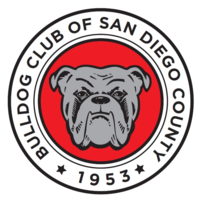Breed Education and Information
BULLDOG CLUB OF GREATER SAN DIEGO
Links to helpful Bulldog sites:
The Bulldog Breed
The Bulldog was originally thought to be a butcher's dog, used to subdue an animal for slaughter. It was then bred to participate in the "sport" of bull baiting, an extremely cruel activity. The original Bulldog had to be courageous, ferocious and savage. It also had to be almost insensitive to pain. Many of the features in the current Bulldog Standard are derived from the physical requirements needed by these dogs.
When bull baiting was outlawed in England in 1835, the Bulldog, as it then existed, had outlived its purpose and would no longer exist as a breed. However, a group of Bulldog lovers felt that the breed should not disappear and decided to preserve it. In order to preserve the breed, they had to remove its undesirable fierce characteristics, while preserving and accentuating its finer qualities. Within a few generations the Bulldog became one of the finest physical specimens of dogdom without the viciousness they previously exhibited. The people who saved the breed formed an organization that eventually became The Bulldog Club, Inc. - the "mother" club of the breed worldwide. When the popularity of the breed came to the United States, the parent club Bulldog Cub of America was formed (aka BCA).
Today, the Bulldog is considered a companion dog with a very even temperament. They love people and make wonderful family pets, with a general affinity for children. While not necessarily a "guard dog", they do make great "watch dogs" in that they will bark and let you know of any potential intruders.
A Bulldog does best in a nurturing environment, full of love and affection, free from fear and neglect. They are very human-oriented and are the most happy with their family. They don't do well with limited human interaction, and indeed thrive on our attentions. Bulldogs should NEVER be an entirely outside dog, relegated to the backhard only through fencing or chaining. They need to be INDOOR dogs, and require air-conditioning in hot weather. Be sure to keep them inside in air conditioning when temperatures soar.
Left alone, a Bulldog (like any other breed) can be destructive. A crate is a good option when a puppy must be left alone. It is a source of protection and security but during the daytime should only be used for short periods. A crate is also very useful for house-breaking. No dog should be left in a crate all day. A Bulldog should never be chained, or otherwise left in your backyard alone. Not only is it dangerous to your Bulldog's well being, but a Bulldog is a high target breed for dognappers.
An often misleading stereotype is Bulldogs are lazy and like to sleep a lot. True, they can be sedentary, but as a breed they can be very active. It is important to make sure they have the appropriate stimulation through training, playtime and rewards. Besides Conformation, many Bulldogs successfully train and compete in Rally, Obedience, Agility and Tracking, even Lure Coursing and Dog Carting! While activity and exercise to maintain good health, one must realize that Bulldogs are not jogging or cycling partners. Without supervision, they can get overheated easily, particularly when it is hot or humid.
As with other short nosed (Brachycephalic) breeds, it is necessary to keep a watchful eye on your Bulldog in hot weather or in any stressful situation, making sure he has shade and clean water. NEVER leave your Bulldog alone in the car in warm weather—even a couple of minutes could prove fatal.
Like any other breed, Bulldogs may be prone to a variety of health problems, but they are not always the "walking vet bill" that is a commonly held belief. Buying your Bulldog from a reputable Bulldog breeder is paramount. Before you buy ask the breeder about health problems in their bloodlines. Ask if they OFA health test their dogs, and if so, ask to see the resulting OFA passing health certificates. Be aware, though, that while many Bulldog breeders test for known genetic issues, even if both parents are healthy, a puppy can develop a problem, which can crop up from several generations back. Buying a puppy should be done with care, and not on the spur of the moment. Take time to research the breed and find a breeder with whom you are comfortable and trust.
Some common Bulldog health problems you may encounter are: an elongated soft palate, small trachea, allergies, dermatitis, demodex mange, ectropion and entropion (eyelid anomalies), cherry eye, stenotic nares, patella luxation, hip dysplasia, and heart problems. Not all veterinarians are knowledgeable when treating Brachycephalic breeds. Obtain a veterinary reference from your breeder, or your local Bulldog club.
The Bulldog is not a breed for everyone, but he will amply reward those who invest time and energy in caring for him, training him, and connecting with him, with his abundant love and humor.
BCA Written Standard. The Written Standard is the "Bible" of the Bulldog. It describes the essence of the breed, its physical appearance and temperament.
BCA Illustrated Standard. The Illustrated Standard was developed as an addendum to help clarify and better understand the concepts put forth in the Written Standard.
These two documents represent the conceptual foundation for our breed.
Rare, Exotic, and Fad Colored Bulldogs. There is a growing trend in incorrect, non-Standard colored Bulldogs. Please read the article entitled: Phenomenon of Rare, Exotic and Fad Colored Bulldogs.
UPDATE: The BCA Council voted unanimously in November 2015 to revise the BCA Written Standard to make non-standard colors a disqualification.
We encourage all BCA members to vote "YES" to the standard revision.
Please click on the following articles to learn why this change is necessary.


